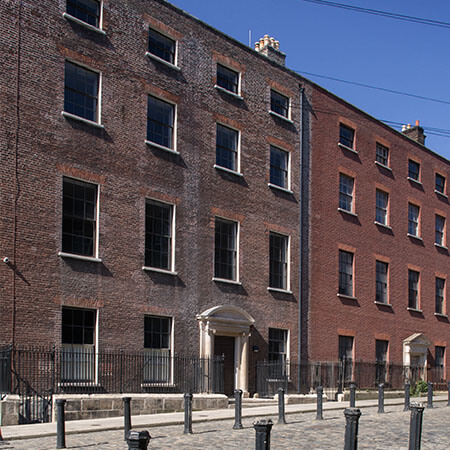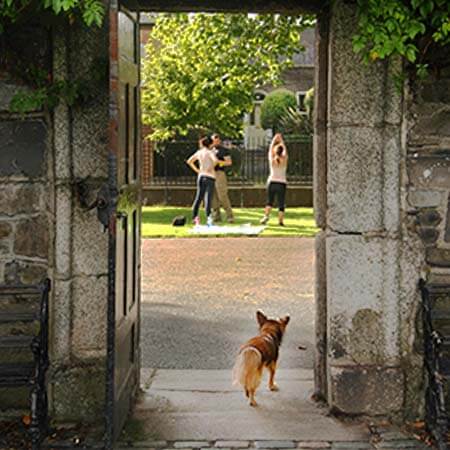Repurposing? Dublin is full of it these days. Old distilleries become luxury apartments, a former telephone exchange transforms into a supermarket, and an ex-railway station becomes a bar. Check out Bank of Ireland on College Green for an earlier and perhaps more noble example of repurposing in the city.

Standing on the traffic island on College Green and looking up, it’s difficult not to be impressed. Surely this is the grandest bank you’ve ever seen. There’s a royal coat of arms. Statues of Hibernia (the Latin name for Ireland), Fidelity and Commerce. And at ground level, a couple of cannons. Oh, and a sentry box.
They’re all clues to this building’s former role because, for the first 61 years of its life, it was home to the Irish Houses of Parliament. In 1800, however, the Irish parliament voted itself out of existence, and its former premises became the Bank of Ireland’s flagship branch in 1803.
The building was the first purpose-built bicameral houses of parliament in Europe (‘bicameral’ meaning it had two ‘chambers’: a House of Commons and a House of Lords.) But it’s been a bank for far longer than it was ever a seat of government. This fact is emphasised by John McGrath, whose job as premises manager is to look after the place. He points out that a good deal of its current appearance inside and out results from the bank’s long stewardship of the building. This includes, most notably, the work of architect Francis Johnston who added to and amended the work of architects who had worked on it previously, including Edward Lovett Pearce and James Gandon.

The pride that McGrath takes in his bank is evident. “When you walk in here in the morning time, he says, “you do a little bit of a double-take and think, ‘My god, how lucky I am to work in such an extraordinarily beautiful building in the city centre of a European capital.’”
Of course, he’s also working in a place that has witnessed many events of historical significance. It’s where the Act of Union was passed into law, joining Ireland with Great Britain and bringing the United Kingdom into existence. It’s also where, as McGrath puts it, a man “was sent by General Michael Collins to… well, how should I put it, encourage – with a pistol – the Bank of Ireland, then considered to be very old-fashioned, Protestant and ascendancy to open an account for the new-fledged Sinn Féin party and later for the Free State government.”

Directly outside the Bank of Ireland is College Green, which McGrath calls ‘Dublin’s drawing room’. “When people all over the country talk about central Dublin or the Dublin city centre,” he says, “this is where we think of. Whenever a large public event needs to be held and an assembly of people needs to be brought together, the bank is asked if we’ll pull on the blue Jersey for Dublin and the green jersey for Ireland, and the answer has always been, ‘Yes, of course.’ So, we’ve had everything from the homecoming from Italia 90 to Bill and Hillary Clinton, and Barack Obama.”
Today as you walk through College Green, McGrath insists that you be on your guard against what he calls the various ‘shibboleths’ peddled by walking tours and open-top bus guides about the building. His least favourite of these is the so-called origin of the phrase ‘daylight robbery’ (a common misconception that the building has no windows due to a tax at the time). The building was completed years before this tax was introduced.
As the building is a bank before anything else, its first duty is to its customers rather than to architecturally or historically inclined visitors. Its banking hall is the oldest still in operation in Europe. It has its own preservation order, glorious carvings and beautiful plasterwork. It doesn’t have any bars, railings or bulletproof glass, notwithstanding that Sinn Féin account. All in all, a very civilised place to do business.

However, if you want to visit as a history or architecture enthusiast, the House of Lords is open on weekdays between 10 am and 12 pm. Tuesdays are the ideal day to visit, though, as Philip, a registered tour guide and former Bank of Ireland porter, is on hand to provide information to visitors. On the other days, your visit to the chamber is self-guided, with an information board giving context to its many artefacts. The chamber features two iconic tapestries depicting King William of Orange and King James I, first hung in 1736, and houses the mace of the Irish House of Commons, made with €250,000 worth of silver.


